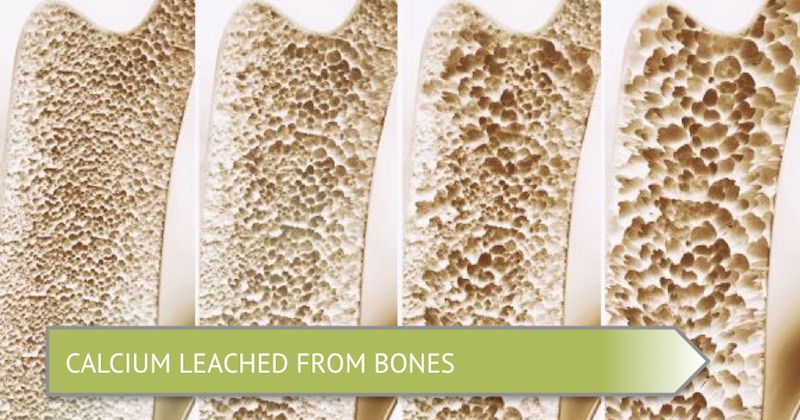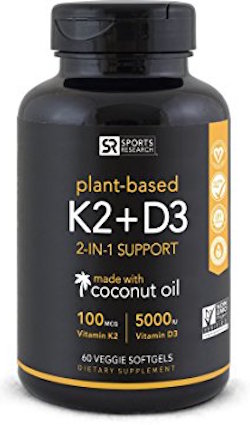The Dark Side Of Vitamin D Supplement—Are You Doing It Right?
Last updated on
Chances are you already know that having enough of vitamin D, the “sunshine vitamin”, is crucial for your health. It plays a huge role in the process of bone mineralization and calcium metabolism in general, so it’s not a surprise that a lot of people start taking supplements to get more of it.
However, you should know that supplementing with vitamin D, if done the wrong way, may be dangerous to your health.
What is the right way, then? Funny enough, but the vitamin K is the key to this puzzle.
Vitamins D and K: What Are They And What Do They Do?
Both vitamin D and vitamin K are part of the so-called group of fat-soluble vitamins (A, D, E, K), meaning that they are absorbed better in your body in the presence of foods with the right kind of fats.
Vitamin D
Vitamin D is actually a collective name for 5 similar substances, the major of which are vitamins D2 and D3. Among them, vitamin D3 is the most important one as it’s found in foods AND produced by the human skin.
Its main function is to regulate calcium levels in your body through 2 simple mechanisms:
- First, it increases the absorption of calcium from dietary sources.
- Second, if there’s not enough calcium in the food you eat and your blood calcium levels go down, vitamin D starts taking calcium from the bones to bring your blood calcium level back to normal.
So, to wrap it up, the goal of vitamin D is to keep blood calcium levels normal at all costs, even if it takes breaking down a bit of your bones.
The real problem here is that vitamin D has NOTHING to do with where this calcium goes. It’s free or “stray” calcium. We’ll get to that in a moment, so keep reading …
Vitamin K
Now, Vitamin K is a small family of similar vitamins (K2 and K3) that are essential for the production of blood-clotting proteins (the K itself is derived from the word Koagulat, the German word for, well, coagulate). Without it, even small injuries can lead to rather nasty bleeding.
Another important function of vitamin K is activating osteocalcin, a calcium-binding protein in the bones. In other words, this vitamin pumps calcium into the bony tissue, making it stronger and denser.
And this is where stuff gets really interesting.
The WRONG (And Dangerous) Way of Taking Vitamin D Supplement
Sadly, it’s also the most widely adopted way. Here’s how it goes.
When a person starts taking a vitamin D supplement, it boosts the absorption of calcium from foods, as said above. Blood levels of this mineral gradually go up in a dose-dependent manner and can even go way higher than the upper acceptable limit (this is called hypercalcemia).
Without proper bone absorption, this “stray” calcium circulates through the body uncontrolled, ends up pretty much everywhere, and causes many health problems:
- In joints, causing joint pains and inflammation
- In the blood vessels, causing calcification and blockages
- Calcification of the heart arteries increases cardiovascular risk
- Stray calcium can also cause stones in gallbladder, kidneys and even damage the brain cells
- Excess or stray calcium causes bone spurs
- High blood calcium levels are linked to elevated blood pressure
NOTE: It is different when vitamin D is obtained from sunshine, as it does not cause the side effects as a vitamin D supplement does.
Long story short, taking vitamin D the WRONG way leads to the calcification of blood vessels, and thus, systemic inflammation.
So how should you take vitamin D, then?
The RIGHT Way of Taking Vitamin D: With Vitamin K or Magnesium!
Besides its role in blood-clotting regulation, Vitamin K is the nutrient that puts your blood calcium to good use, thanks to the activation of osteocalcin. The latter is a protein that captures calcium and incorporates it into building your bones and teeth.
Vitamins D and K work synergistically: Vitamin D ensures a steady calcium supply while vitamin K pumps it into the tissues where it is needed, and protects the rest of them.
Scientific studies speak in favor of this fact. For instance, it has been confirmed that vitamin K deficiency contributes to blood vessel calcification. The opposite is also true: taking vitamin K prevents this detrimental condition.
Role Of Magnesium Against Stray Calcium
Magnesium is a key cofactor in more than 300 enzyme-driven biochemical reactions, and a key mineral in hundreds of functions in the body. The tasks that magnesium is needed in, are too complex, but you can imagine that the deficiency of this mineral could easily cause many functions in your body to spiral out of control.
Most of the factors that contribute to calcium toxicity contribute to a depletion and deficiency of magnesium. One of the main functions of magnesium is to help your body absorb calcium and make it available for bone-building.
In the absence of magnesium (or vitamin K), calcium is malabsorbed and “runs loose” to be deposited elsewhere in the body, but the bones. This is another factor for calcification to take place. Read more here.
Vitamins D and K: How Much Should You Take Each?
To recap: the only right way of taking vitamin D is to couple it with vitamin K.
Specifically, look for a healthy dose of vitamin D3 and K2, as those specific subtypes have better bioavailability in humans.
Now, as to how much of these two vitamins you should take, there is no universal rule at the moment.
When it comes to supplements, things get a little trickier because it’s hard to calculate how much of these nutrients a person is getting in total (from the supplements plus dietary sources).
Most independent experts, however, recommend taking about 150 to 200 mcg of K2 for every 5,000 to 10,000 IU of vitamin D3.
If you wish to take a vitamin D supplement, getting vitamin D3 + vitamin K2 together in the right ratio is helpful. Either of these combo supplements come highly recommended:
- Sports Research 100% Plant-Based Vitamin K2 + D3 with Organic Coconut Oil
- Zhou Nutrition Vitamin D & K Complex Bone and Heart Health Formula
Dietary Sources of Vitamin K
Besides considering supplements of vitamin K to ensure an optimal calcium balance when taking D3, don’t forget that you can get it from foods as well.
There are two main forms of vitamin K:
- K1, phylloquinone; found in dark leafy greens
- K2, menaquinone; found in animal products, fermented foods, and produced by the intestinal bacteria from vitamin K1
They are very similar in structure, functions, and effects. Basically, the only difference is that K1 has low bioavailability, meaning that it’s poorly absorbed from dietary sources. K2 is absorbed better, is more effective, and circulates longer in your body.
Foods rich in vitamin K1 (mcg/100g): collards (440), spinach (380), soybean oil (193), broccoli (180), cabbage (145), canola oil (127), iceberg lettuce (35).
Foods rich in vitamin K2 (mcg per 100 g): natty (1034), goose liver (369), emu oil (360), hard cheeses (76), soft cheeses (56), egg yolk (32), grass-fed ghee (29), butter (15).
Conclusion
The human body is an incredibly delicate thing. You can’t expect to come across a magical super-pill (or food, or nutrient, or mineral) that will be universally healthy for you—there are just too many interactions to consider.
Vitamin D is one of such things. It’s absolutely important, it plays a crucial role in dozens of processes in your body—but take it the wrong way, and it will do you more harm than good.
Now that you know the RIGHT way of taking it: don’t leave out the K2! 🙂
Some of the links I post on this site are affiliate links. If you go through them to make a purchase, I will earn a small commission (at no additional cost to you). However, note that I’m recommending these products because of their quality and that I have good experience using them, not because of the commission to be made.




































 JOIN OVER
JOIN OVER
Comments